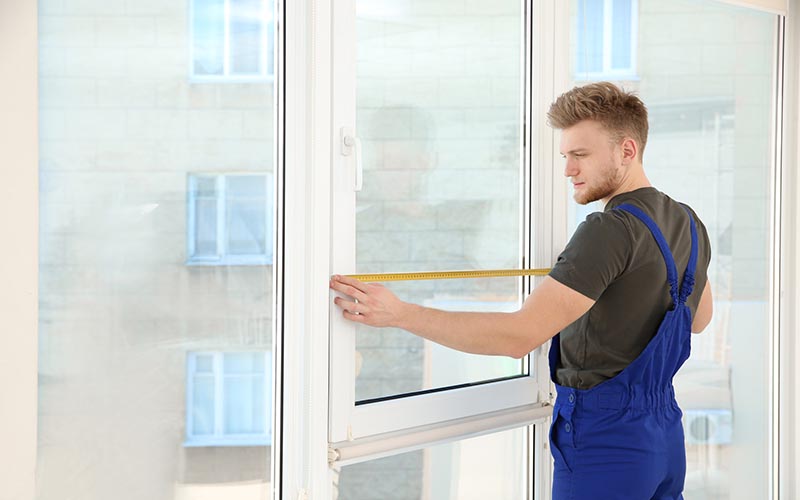When you’re looking to install or upgrade windows in your home, it’s a good idea to learn some of the conventions and measurements that are typically used to size everything properly.
One of the first things you’ll want to figure out is what is the standard window height from floor level to the ceiling.
A window usually begins at about 36 inches above your home’s floor. The window itself will then range from 40 to 60 inches tall. The space between the top of the window and the ceiling is usually 18 inches.
This is all assuming that you have an average-sized home with standard rooms and ceilings.
It’s important when making this measurement that you include the height of your window’s frame and molding into account.
Read on to learn more about how to choose the right window size and how to place them perfectly in your home.
Table of Contents
- How Do I Decide Where To Place Windows In My Home?
- Decide How Much Wall Space You Want To Be Glass
- Decide on the Width of Your Windows
- Decide on the Window Height
- Decide Which Directions the Windows Will Face
- Make Sure Your Windows Are Private
- Make Sure Your Home Will Be Well Ventilated
- Types of Windows for Your Home
- Final Thoughts
How Do I Decide Where To Place Windows In My Home?
There are many factors to consider when deciding where to put windows in your home, including which rooms you want more light and airflow or how much natural sunlight is available.
When deciding on window placement and spacing, you’ll want to make sure to consider your aesthetic preferences, the practical capacity of your walls, and the opinions of your contractors and builders.
Here are some other helpful tips that can help you place your home’s windows appropriately.
Decide How Much Wall Space You Want To Be Glass

Of course, one of the most obvious factors in where you place windows is whether or not there will be enough wall space to accommodate them.
You’ll want to consider how much glass area you would like from floor level all the way up to your ceiling height.
The average window size is about 40 inches tall.
If you want to take advantage of the standard window height from floor level to ceiling, then this is how much wall space you’ll need in order for your windows to fit properly.
However, there are many reasons why you may want larger windows, such as if you want to have a lot of natural sunlight.
Longer windows measure between 65 and 72 inches tall.
Keep in mind that the taller the window, the larger its frame and sill will be too.
Smaller windows are best for rooms that don’t get much natural light.
They will be cheaper and easier to install in your home.
Decide on the Width of Your Windows

You can choose from landscape windows, portrait windows, or install several windows in a row that create both effects.
Less common options such as oval or circular windows are available as well. Landscape windows work best in rooms that aren’t very tall, while portrait windows work best in longer and wider spaces.
When choosing the size of your window frames, you will want to stay consistent with your choice throughout each room.
For example, don’t install a portrait window on the right side of a wall and a landscape window on the left. Sticking with the same orientation will help to create a more cohesive look in your home.
Decide on the Window Height

If you place your window high on your wall, the space will seem to be “heavier” on the bottom.
These types of windows are common in garden apartments that are partially underground but aren’t recommended for homes because they can make rooms seem smaller.
If you place your windows low on the wall, the space will appear to be “lighter” on top.
The negative space at the top of the wall will create a sense of openness. The lower windows will ensure that they allow light to flow into your room more easily.
Placing your windows in the middle of a wall can also create an effect of openness and freedom.
This will also create a balanced and symmetrical effect in the home.
Decide Which Directions the Windows Will Face
In general, it’s best to place the majority of your windows in a south-facing wall.
This will make sure that you have the most light possible throughout the year.
If you place your windows in a north-facing wall, you will get less light during all seasons except the summertime.
East-facing windows are a great option for spaces that will be used in the morning, while west-facing windows are best for rooms where you’ll relax or entertain at night.
Just remember that the light will be very direct in these windows since it will be in the path of the sunrise and sunset.
You’ll also choose to place your windows in areas where you will have the best view.
If you’re in an urban area and you’re very close to another wall, you probably don’t want to install a large window.
However, if there is a skyline view, you’ll want a generously sized portrait window so that you can take advantage of the scenery.
The same applies for more natural views.
Maximize your windows in areas where the view is pleasant and minimize them in areas with a limited view.
Make Sure Your Windows Are Private
Privacy is one of the most important considerations when deciding where you will place your windows.
The lower your windows are placed and the larger they are, the easier it will be for people to see inside. Consider installing frosted windows or adding additional window treatments to ensure that your home is private.
You may also want to add more windows in areas that are facing trees, foliage, or other types of natural barriers.
Make Sure Your Home Will Be Well Ventilated
Windows are about more than design and lighting.
They also provide safety by allowing you to ventilate your home.
Make sure that you install windows in areas where the airflow is good and there are no obstacles to prevent adequate ventilation.
You can assess what directions breezes come from on your property and place windows accordingly.
This will help to create a more comfortable home, as well as reduce your energy bill by allowing you to use natural ventilation instead of your air conditioning system.
Certain windows are non-operable and fixed, meaning that they never open.
You’ll want to install these windows in areas where the airflow is already good, like on a porch or balcony.
Types of Windows for Your Home

When you’re deciding what the window height from floor-length should be, you’ll want to consider what type of window you will be using first.
Here is a list of some common window types you may want to install in your home:
- Double-hung windows: These windows are the most common because they provide decent ventilation and allow you to open them fully.
- Casement windows: These types of windows can be opened and closed by turning a crank. They’re great for areas with poor ventilation, like bathrooms or mudrooms.
- Awning windows: These windows are best for areas with high humidity, like a kitchen or bathroom. They’re also great at providing ventilation without having to lift the window entirely.
- Picture windows: These windows are great for maximizing views and can be floor length or shorter.
- Bay/bow windows: These types of windows come in a variety of shapes, but are best for providing a lot of natural light.
- Garden/horizontal windows: These types of windows are great at creating a foresty or garden feel without having to install a window box.
- Floor to ceiling windows: These windows are great for creating a feeling of openness and they let in maximum natural light.
When choosing the right windows for your home, you’ll want to factor in your budget, personal taste, and the functionality you need the windows to have.
Final Thoughts
While there is a standardized placement for window height of 36 inches above the floor, it is not an exact rule and there are many variations you can embrace in your home.
Make sure you focus on any specific building codes to take safety precautions and install your windows in a way that suits your lifestyle.
This will guarantee you years of bright and beautiful windows that exceed your expectations.
Related:
